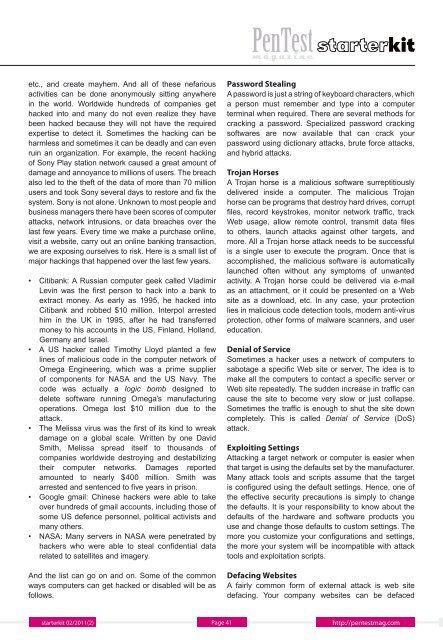Editor's note
Editor's note
Editor's note
You also want an ePaper? Increase the reach of your titles
YUMPU automatically turns print PDFs into web optimized ePapers that Google loves.
etc., and create mayhem. And all of these nefarious<br />
activities can be done anonymously sitting anywhere<br />
in the world. Worldwide hundreds of companies get<br />
hacked into and many do not even realize they have<br />
been hacked because they will not have the required<br />
expertise to detect it. Sometimes the hacking can be<br />
harmless and sometimes it can be deadly and can even<br />
ruin an organization. For example, the recent hacking<br />
of Sony Play station network caused a great amount of<br />
damage and annoyance to millions of users. The breach<br />
also led to the theft of the data of more than 70 million<br />
users and took Sony several days to restore and fix the<br />
system. Sony is not alone. Unknown to most people and<br />
business managers there have been scores of computer<br />
attacks, network intrusions, or data breaches over the<br />
last few years. Every time we make a purchase online,<br />
visit a website, carry out an online banking transaction,<br />
we are exposing ourselves to risk. Here is a small list of<br />
major hackings that happened over the last few years.<br />
• Citibank: A Russian computer geek called Vladimir<br />
Levin was the first person to hack into a bank to<br />
extract money. As early as 1995, he hacked into<br />
Citibank and robbed $10 million. Interpol arrested<br />
him in the UK in 1995, after he had transferred<br />
money to his accounts in the US, Finland, Holland,<br />
Germany and Israel.<br />
• A US hacker called Timothy Lloyd planted a few<br />
lines of malicious code in the computer network of<br />
Omega Engineering, which was a prime supplier<br />
of components for NASA and the US Navy. The<br />
code was actually a logic bomb designed to<br />
delete software running Omega’s manufacturing<br />
operations. Omega lost $10 million due to the<br />
attack.<br />
• The Melissa virus was the first of its kind to wreak<br />
damage on a global scale. Written by one David<br />
Smith, Melissa spread itself to thousands of<br />
companies worldwide destroying and destabilizing<br />
their computer networks. Damages reported<br />
amounted to nearly $400 million. Smith was<br />
arrested and sentenced to five years in prison.<br />
• Google gmail: Chinese hackers were able to take<br />
over hundreds of gmail accounts, including those of<br />
some US defence personnel, political activists and<br />
many others.<br />
• NASA: Many servers in NASA were penetrated by<br />
hackers who were able to steal confidential data<br />
related to satellites and imagery.<br />
And the list can go on and on. Some of the common<br />
ways computers can get hacked or disabled will be as<br />
follows.<br />
starterkit 02/2011(2)<br />
Password Stealing<br />
A password is just a string of keyboard characters, which<br />
a person must remember and type into a computer<br />
terminal when required. There are several methods for<br />
cracking a password. Specialized password cracking<br />
softwares are now available that can crack your<br />
password using dictionary attacks, brute force attacks,<br />
and hybrid attacks.<br />
Trojan Horses<br />
A Trojan horse is a malicious software surreptitiously<br />
delivered inside a computer. The malicious Trojan<br />
horse can be programs that destroy hard drives, corrupt<br />
files, record keystrokes, monitor network traffic, track<br />
Web usage, allow remote control, transmit data files<br />
to others, launch attacks against other targets, and<br />
more. All a Trojan horse attack needs to be successful<br />
is a single user to execute the program. Once that is<br />
accomplished, the malicious software is automatically<br />
launched often without any symptoms of unwanted<br />
activity. A Trojan horse could be delivered via e-mail<br />
as an attachment, or it could be presented on a Web<br />
site as a download, etc. In any case, your protection<br />
lies in malicious code detection tools, modern anti-virus<br />
protection, other forms of malware scanners, and user<br />
education.<br />
Denial of Service<br />
Sometimes a hacker uses a network of computers to<br />
sabotage a specific Web site or server. The idea is to<br />
make all the computers to contact a specific server or<br />
Web site repeatedly. The sudden increase in traffic can<br />
cause the site to become very slow or just collapse.<br />
Sometimes the traffic is enough to shut the site down<br />
completely. This is called Denial of Service (DoS)<br />
attack.<br />
Exploiting Settings<br />
Attacking a target network or computer is easier when<br />
that target is using the defaults set by the manufacturer.<br />
Many attack tools and scripts assume that the target<br />
is configured using the default settings. Hence, one of<br />
the effective security precautions is simply to change<br />
the defaults. It is your responsibility to know about the<br />
defaults of the hardware and software products you<br />
use and change those defaults to custom settings. The<br />
more you customize your configurations and settings,<br />
the more your system will be incompatible with attack<br />
tools and exploitation scripts.<br />
Defacing Websites<br />
A fairly common form of external attack is web site<br />
defacing. Your company websites can be defaced<br />
Page 41 http://pentestmag.com


